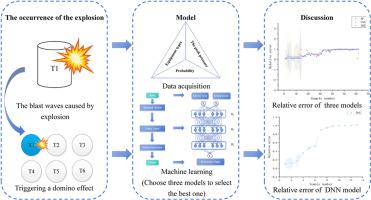Explosion induced domino effect assessment in the process industries: A machine learning approach to improve probit models
IF 4.2
3区 工程技术
Q2 ENGINEERING, CHEMICAL
Journal of Loss Prevention in The Process Industries
Pub Date : 2025-06-17
DOI:10.1016/j.jlp.2025.105714
引用次数: 0
Abstract
Explosion-induced domino accidents in the chemical industry, such as the 2005 Buncefield and 2019 Xiangshui accidents, can lead to catastrophic losses. Recent studies commonly use probit models (simplified linear regression models) to predict the probability of accident escalation caused by equipment failure due to overpressure conditions but necessitate distinct equations for different equipment types. In order to simplify the number of models and improve their accuracy, this study introduced three machine learning models (random forest model, convolutional neural network model, and deep neural network model), addressing complex nonlinear relationships that conventional regression models may not fully capture. By model training, the DNN model has the highest accuracy (99 %), followed by CNN (94 %) and random RF (95 %). The DNN model was selected as the optimal data-driven model for equipment vulnerability assessment due to their feedforward mechanism's capability to dynamically align parameters with evolving data distributions. The approach developed can not only predict the probability of equipment damage by integrating values related to peak overpressure and equipment type but also effectively address the accuracy validation issues associated with traditional regression models. Besides, this approach can be considered open source model and more explosion data may be used in the future to further improve the model.

过程工业中爆炸引起的多米诺效应评估:改进概率模型的机器学习方法
化工行业爆炸引发的多米诺骨牌事故,如2005年邦斯菲尔德事故和2019年响水事故,可能导致灾难性损失。最近的研究通常使用probit模型(简化线性回归模型)来预测由于超压条件导致的设备故障导致事故升级的概率,但不同设备类型需要不同的方程。为了简化模型数量并提高其准确性,本研究引入了三种机器学习模型(随机森林模型、卷积神经网络模型和深度神经网络模型),解决了传统回归模型可能无法完全捕获的复杂非线性关系。通过模型训练,DNN模型的准确率最高(99%),其次是CNN(94%)和随机RF(95%)。由于DNN模型具有前馈机制,能够根据不断变化的数据分布动态调整参数,因此选择DNN模型作为设备脆弱性评估的最佳数据驱动模型。所开发的方法不仅可以通过整合与峰值超压和设备类型相关的值来预测设备损坏的概率,而且可以有效地解决与传统回归模型相关的准确性验证问题。此外,该方法可以被视为开源模型,未来可以使用更多的爆炸数据来进一步完善模型。
本文章由计算机程序翻译,如有差异,请以英文原文为准。
求助全文
约1分钟内获得全文
求助全文
来源期刊
CiteScore
7.20
自引率
14.30%
发文量
226
审稿时长
52 days
期刊介绍:
The broad scope of the journal is process safety. Process safety is defined as the prevention and mitigation of process-related injuries and damage arising from process incidents involving fire, explosion and toxic release. Such undesired events occur in the process industries during the use, storage, manufacture, handling, and transportation of highly hazardous chemicals.

 求助内容:
求助内容: 应助结果提醒方式:
应助结果提醒方式:


